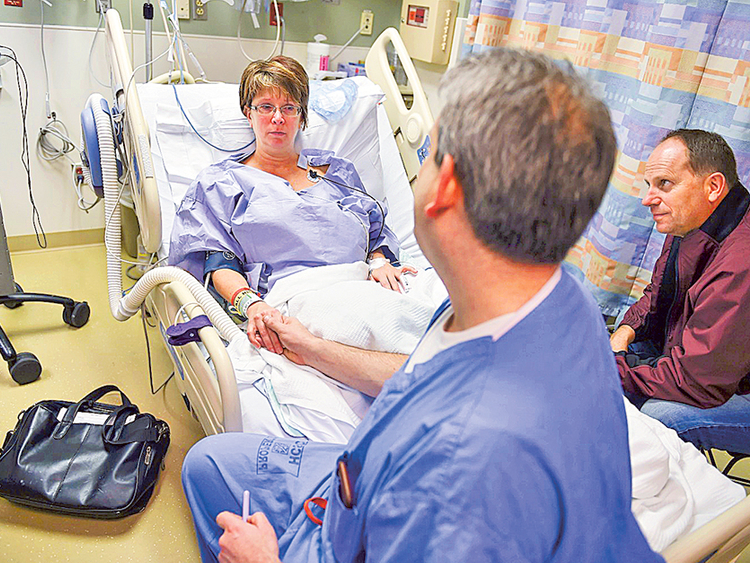
DANVILLE, Pasadena: At Geisinger Health System in Pennsylvania, hospital officials want to keep their customers happy.
So when patients are upset about a long wait in the emergency department, or a doctor’s brusque manner, or a meal that never arrived in a room, Geisinger is doing more than apologising.
It’s offering money back on their care, no questions asked.
The hospital system is the first in the country to adopt what has long been a basic tenet of retail business: customer refunds. This focus on customer satisfaction is a relatively new concept for health care, in which doctors have typically called the shots. And it’s one that Geisinger’s staff questioned when president and chief executive David Feinberg came up with the refund idea last fall.
But the novel approach is in keeping with health care’s shift to improve the experience of patients. Under the Affordable Care Act, government payments are increasingly tied to the quality of care and patient satisfaction as opposed to the quantity of services provided.
“We want to make sure we not only have the right care that is high quality and safe, but we also want to make sure our care is compassionate, dignified and delivered with a lot of kindness,” said Feinberg, who took over Geisinger last May after running the UCLA health system.
One 49-year-old patient received a $210 (Dh771) refund in February after an appointment left her in tears. “Pt. felt like they didn’t care and did not have her best interest at heart. Pt. stated she came to Geisinger b/c she trusted us, she has no trust now,” according to the financial authorisation for the refund.
Karen Hull was upset, too, and not just over the chicken panini that took hours to be delivered after her successful surgery in January. Several weeks earlier, the Geisinger Medical Center finance department had blindsided the 46-year-old dental hygienist with a call for a “down payment” on her operation, for a herniated disk that had caused crippling pain.
“I remember thinking, it’s not like I’m going to skip out on my back surgery,” she said. She wound up paying $100 toward her $2,375 co-payment.
After she got home, she asked for a $150 refund — an amount that reflected her distress.
Hers was among the 74 requests that Geisinger received between October and mid-March. In response to those requests, the system refunded or waived charges of nearly $80,000, officials said. Only co-payments and deductibles can be considered.
When Feinberg announced the program, which began as a pilot and then was expanded to all patients systemwide in early April, other industry executives told him it was “a dumb idea,” he said. But there is less scepticism now given how the feedback already has boosted patient satisfaction scores, a key metric the federal government uses to pay hospitals.
Industry executives at a recent health-plan meeting were “blown away” after hearing the CEO’s presentation, recalled Ceci Connolly, president and chief executive of the Alliance of Community Health Plans. The organisation represents 22 health plans and provider groups, including Geisinger.
“It is sad and ironic that a business that has decided to listen to its customers and be responsive and even occasionally refund some money is considered so out of the box,” Connolly said.
At least one other system — University of Utah Health Care — is looking into a similar program.
In recent years, hospitals nationwide have sought to make care more customer-friendly, with staff retraining and new programs. Yet Geisinger’s move is perhaps the boldest innovation by a system long known for reinventing medical care. A decade ago, for example, Geisinger introduced a 90-day warranty for surgery patients.
Its size and its integration of hospitals, doctor practices and insurance helps to make that possible. It is one of the country’s largest health systems, with 10 hospitals serving more than 3 million residents in Pennsylvania and southern New Jersey, and it claims more than 500,000 members in a health coverage plan it offers. The refund program is in place only at the Pennsylvania facilities. “They can make the math work,” compensating for short-term losses on refunds through longer-term relationships with the insurance customers, Connolly said.
Sceptics’ worries that greedy patients would abuse the system and cite any reason in demanding money back have not proved warranted. And Feinberg maintains that the refund process provides Geisinger with valuable information, spotlighting areas that need improvement. The amounts, which are limited to a patient’s maximum co-pay or deductible, have ranged from $20 to a few thousand dollars.
“We have a built-in secret-shopper program, and the patient is telling us when we get it right,” he said. Most feedback has been positive. Refunds represent “families who had to wait in the emergency room for too long, or were treated by a doctor in an abrupt manner, or the nurse got too caught up in what she was doing and forgot to hold someone’s hand,” he said.
Maureen Bisognano, president emeriti at the non-profit Institute for Healthcare Improvement, agrees.
“If you went out to get a consultant to teach you how to improve patient experience, it would be a lot more than [$80,000],” she said. Plus, the system’s approach gives it real-time feedback “right at the moment of care about what needs to be fixed.” Most important, she said, it sends a message to patients that Geisinger trusts them.
ProvenExperience, as the program is called, allows patients to get refunds in a variety of ways. The quickest is through a specially designed mobile app — a free one — on which patients can rate their experience and put in for a refund for services that took place beginning last November. Requests are typically processed in three to five business days.
At the same time, any of Geisinger’s 30,000 employees can reach out to patients who feel their service or experience is “not good.” Employees can provide “service recovery” with free lunch or dinner vouchers, parking passes or gift certificates for the hospital gift shop. That is also how the system deals with unhappy Medicare patients. The uninsured can get financial credit on a case-by-case basis, officials said.
Though the ultimate goal is to improve patient experience, “the money piece gives us skin in the game,” said neurosurgeon Jonathan Slotkin, who helped design the program.
The top refund requests reflect issues common to many hospitals, including complaints about poor communication with the staff, parking, noisy hospital rooms and billing issues. Some requests come directly from Feinberg, who visits regularly with patients throughout the system and jots down his cell phone number when he hands out his business card.
Feinberg said Geisinger is already making improvements, starting with a new corporate chef to come up with better menus at each hospital. Other changes will take a bit longer. To address emergency-room backlogs, he is working on a plan to eliminate all wait times within three years. That may involve new online registration and ER waiting rooms that could be turned into clinical space where doctors would treat non-emergency patients.
To improve communication, all employees are getting new training to ensure they always introduce themselves to patients, ask permission before performing procedures and tell patients what is coming next.
Within Geisinger, some staffers are afraid that there will be repercussions if a patient wants money back. “If a patient of mine asks for a refund, does that reflect I am a poor-quality physician? I have those own internal fears myself,” Slotkin said.
At a more fundamental level, he said, it is a cultural change for doctors who were trained to treat relationships with patients as “sacrosanct and precious” — and certainly different from selling shoes or sofas. “People don’t respond to change well,” said Anthony Petrick, who heads bariatric surgery at Geisinger.
But he and others said they also understand that as patients pay an ever-greater share of the cost of their care, hospitals need to understand that they are customers who must be treated with dignity and respect.
Kim Walsh didn’t even know she could get money back. The pharmacist, 51, had undergone thyroid surgery in December. The operation was successful, but her stay was calamitous.
At Geisinger’s Wyoming Valley Medical Center in Wilkes-Barre, Pennsylvania, Walsh was assigned a room with no toilet. She had to use a public bathroom, which meant asking staff for help to get out of bed and walk down a long hallway. She remembers one particularly rude aide. On her last trip, there was urine on the seat and no toilet paper. She called her husband in tears.
The hospital’s patient-advocate representative was appalled and assured Walsh she wouldn’t have to pay the remaining $785 of her deductible. Walsh hopes hospital staffers have learnt an important lesson.
“I would have rather been treated well and paid my 800 bucks,” she said.”













